🧬 Lecture 1
1/30
There's no tags or description
Looks like no tags are added yet.
Name | Mastery | Learn | Test | Matching | Spaced |
|---|
No study sessions yet.
31 Terms
Survivors of Evolution
Organisms are programmed to constantly diversify genetically
Helpful selection removes deleterious alleles
Balance of diversification + selection → improved fitness in changing, competitive environments
Fitness
Diversification + vulnerability to helpful selection
Ability of organism, population, or species to survive, find mate, produce offspring in environment
e.g. Covid
Persistence due to constant new genetic variants
Shows power of diversification
If tiny virus can do this → imagine power of plants or animals with constant diversification
Primordial Soup
3.8 B years ago
No O2 (oxygen came from plants)
High in carbon, nitrogen, sulfur, inorganic phosphorus (PO₄³⁻)
Heat energy, H2O present
What is Life?
Empiricial/functional definition: Programmed series of biochemical reactions that build complex structures from simple elements + molecules (e.g. CO2, N2 gas in the atmosphere, phosphorus, sulfur, H2O, etc.)
Facilitated by enzymes, each encoded by a gene
What’s Needed for Chemical Reactions to be Efficient
Rxns need to be contained within semi-permeable membrane (H2O and molecules within can’t pass through)
Hydrophobic (lipid/fat) cell membrane
Key reason why organisms need to build + consume fats/oils
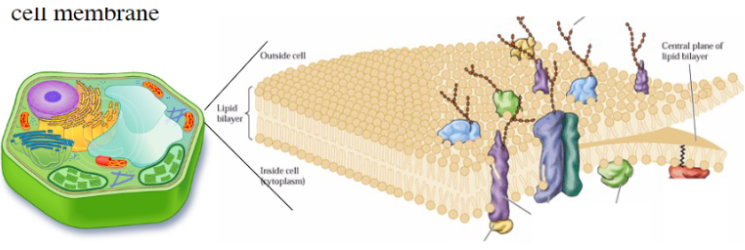
What Else is Needed for Chemical Rxns to be Efficient - Enzymes
Key to all life on Earth
Hydrophobic on outside
Without enzymes: 2 reactive molecules rely on random diffusion to “find” each other
With enzymes: Active site binds both molecules, holds them close, allows rxn to occur
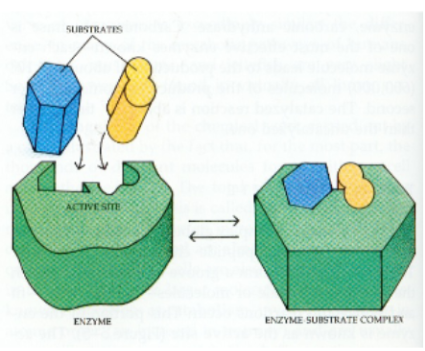
What Encodes an Enzyme?
Genes (segments of DNA)
What is the Function of a Gene?
To encode an enzyme + other proteins
Minimal # of Unique Genes Required to Make Multicellular Life
11k to 15k
Humans have ~21k genes
Corn has ~40k genes
Do Genes Float Around in a Cell Freely?
No, they’re in the nucleus
Consequence of Free-Floating Genes After Cell Division
Genes wouldn’t be distributed equally
Daughter cells would lose genetic information
Life would not be sustainable
How Did Evolution Solve This?
Genes are organized into chromosomes
Chromsomes ensure accurate replication + segregation during cell divison
Chromosome Structure
DNA-based genes linked together in long, wound-up “string”
DNA wraps around histones to form nucleosomes for structural support
DNA becomes highly compacted (multi-folded) to fit inside nucleus
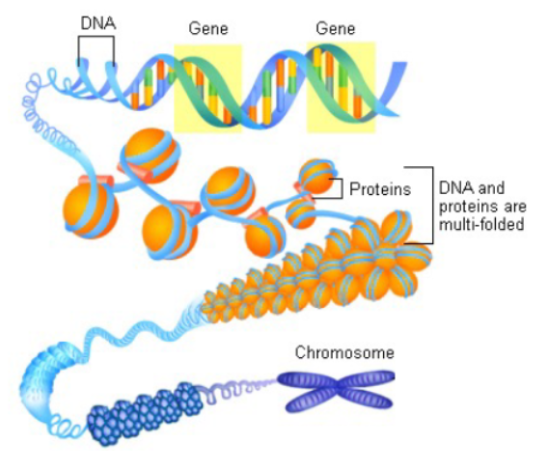
DNA Length (Outstretched)
205 cm in males
208 cm for females
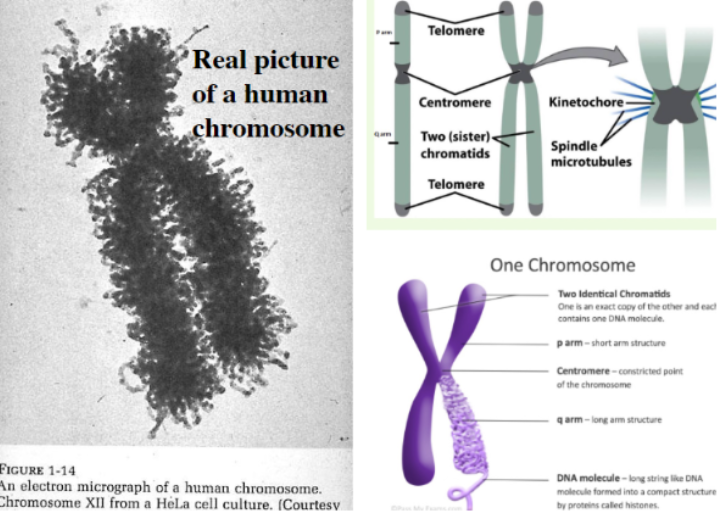
Mitosis
Type of cell division used by higher organisms
Ensures both resulting cells receive all genes
Chromosomes of daughter cells are same # as that of founder cell

Asexual Plant Propogation
Plants from cuttings regenerate by mitosis (genetically identical to parent)
Advantage: Maintains desirable traits
Disadvantage: No genetics variation (less adaptability)
Plants are propagated vegetatively/asexually by taking cuttings and placing them in water/soil/ cutting off the top (ratooning)
e.g. Sugarcane regenerates asexually from ratoon (cut stem)
Ornamental plants regenerate from cuttings
Potatoes regenerate from tuber pieces
DNA Replication + Mutation
Inherently makes mistakes (since it has multiple mechanisms), making new alleles
Every mitosis carries risk of mutation
Temp effect: Every 10 °C increase → mutation rate rises 2–3 times → potential link to climate change
Byproducts of cell metabolism (normal growth, G1, S, G2) can also mutate
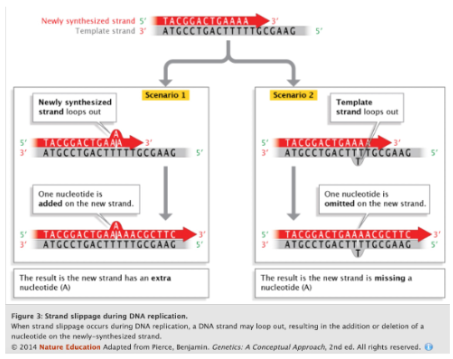
UV Radiation + DNA
UV radiation > 260 nm is strongly absorbed by nucleotide bases
Absorption can result in mutations
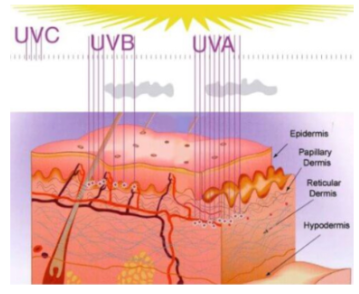
Mobile Elements and Insertional Mutations
Mobile elements (jumping genes, mobile DNA, selfish DNA) create insertional mutations in host chromosomes
Intracellular parasites that insert into genes and cause mutations
Include: Transposon, retroelements, retroviruses (e.g. HIV), interspersed elements
Can exist in dozens to millions of copies in higher organisms

Chemical Mutagens
Polycyclic Aromatic Hydrocarbons (PAHs)
From burning natural/industrial materials (e.g. forest fires, refineries, vehicle exhaust)
Nitrosamines
From tobacco, smoked meats/fish, nitrite preservatives in food
Alkaloids from Plants
Natural compounds
Benzene
Industrial solvent and precursor for drugs, plastics, synthetic rubber, dyes
Alcohol
Fungal Mycotoxins
In infected foods
Types of Mutations (IDRIS)
Insertions
Adds extra bases
e.g. CAGTAG → CATGTAG
Deletions
Removes bases
e.g. CAGTAG → CATAG
Substitutions
Replaces base with another
e.g. CAGTAG → CAATAG
Inversion
Reverses bases
e.g. CAGTAG → GATGAC
Repeat Expansions
Copy same base sequence multiple times
e.g. CGGCGGCGG → CGGCGGCGGCGGCGGCGG
Alleles
Allele: Variant of gene caused by small mutations
Therefore, all genes come from earlier genes
Dominance + Recessiveness
Both alleles may encode proteins
e.g. Brown (B) vs. blue (b) eye color
Gene encoding protein that “does the job stronger” (e.g. produces more of the protein necessary) is dominant
e.g. Allele B: functional protein → brown eye pigment, masks blue
Allele b: no protein or little protein → blue eye pigment
Most alleles are codominant (both proteins contribute to function) or incompletely dominant
e.g. Flower colors, coat colors
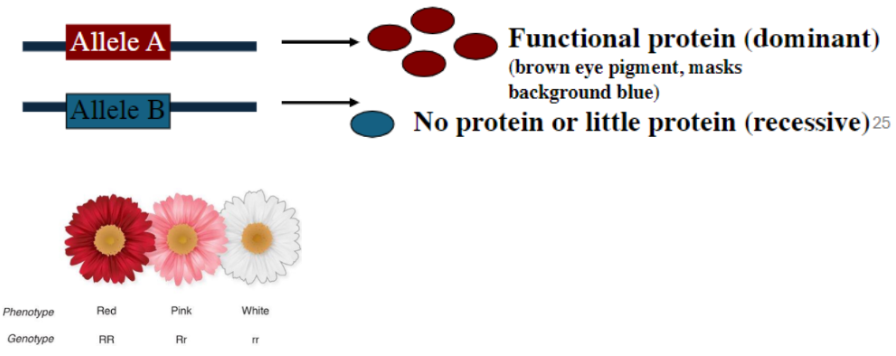
Spontaneous Mutations and Diversification
Spontaneous mutations that produce new alleles are major engine of life’s diversification
Can have dramatic impacts (e.g. Covid variants)
Multiple alleles (genetic variants) can exist for a single gene within a population
e.g. Blue, brown, green eyes
Mutations from thousands or millions of years ago can persist and help trace shared ancestry (pedigrees)
Mutations can eventually produce entirely new genes and enzymes
All genes derive from earlier genes → all life on Earth is related, sharing common ancestors
Sex and Genetic Diversity
Sex introduces genetic diversity from two individuals
In most higher organisms:
Each gene (locus) has a maternal allele and a paternal allele
Heterozygous: Two different alleles at a gene
Homozygous: Identical alleles at a gene (used in inbred crops or purebred animals)
Natural selection favors sex to create genetic diversity with redundancy
Redundancy (having two copies of an allele that have the same purpose, e.g. eye color) allows safe allelic experimentation in case one allele is harmful/nonfunctional/mutated negatively, the other can still “do the job”
Additional Terms
Sister chromatids: Two identical copies of a single chromosome
Formed during DNA replication
Joined at centromere
Homologous chromosomes
Pair of chromosomes (one maternal, one paternal)
Contain same genes but may have different alleles
Separate during meiosis to increase genetic diversity
Simple early life was haploid (could easily replicate by mitosis, no meiosis, no need for mate)
Only one copy of each chromosome, only 1 allele at each gene

Haploid Parental Gametes
Each parent contributes one haploid (n) gamete (one copy of each chromosome)
Female × Male → F1 (1st filial generation)
By convention, female parent is listed first in a genetic cross

Utility of Two Alleles at a Gene After Sex
Creates genetic diversity within a generation → May be beneficial
Enzymes encoded by genes can affect multiple traits or multiple stages
A novel allele might improve one trait/stage but harm another
Redundant chromosome from sex allows:
Safe experimentation with novel alleles
Retention of beneficial alleles in population
Promotion of long-term diversity (critical concept)
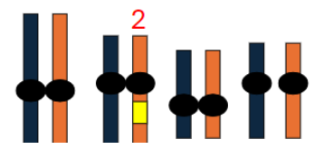
Utility of Two Alleles at a Gene
In a haploid, slightly deleterious (bad) or neutral alleles:
Likely eliminated quickly or drift out slowly
Limits genetic diversification → Organism stays simple
Experimental sex provides safe allelic experimentation
In higher plants and animals, diploid/polyploid “safe space”:
Needed to unleash full diversification potential of meiosis
Meiosis occurs before sex
Summary
Life is a programmed series of biochemical rxns, facilitated by enzymes, each encoded by a gene
To facilitate reproducible transmission to daughter cells, genes are linked together to form chromosomes
Chromosomes replicate to facilitate multicellularity and simple replication (e.g. mitosis)
DNA replication, parasites, and mutagens cause mutations (new alleles)
Natural selection favors sex to create genetic diversity with redundancy, permitting safe allelic experimentation
Reading 1: George Beadle: From Genes to Proteins
Early life: Born in 1903, grew up on a farm in Wahoo, Nebraska; originally interested in farming, shifted to genetics in college
Education and mentors: Studied at University of Nebraska (College of Agriculture) and Cornell University; influenced by F. D. Keim and Rollins Emerson; gained early experience with maize genetics
Caltech and Drosophila: Postdoctoral work at Caltech with Thomas Hunt Morgan’s Fly Group (Sturtevant, Bridges, Dobzhansky, Schultz); mastered Drosophila genetics, crossing-over, and chromosome behavior
Early research: Worked with Boris Ephrussi on eye-color mutations in Drosophila; demonstrated genes control specific steps in metabolic pathways (vermilion → kynurenine, cinnabar → 3-hydroxykynurenine)
Insight from Tatum: Inspired by Edward Tatum’s lecture on genes and metabolic function; led to experiments linking genes to enzyme production
Neurospora crassa experiments: Induced mutations using radiation; identified nutritional mutants with single-gene defects; established the one gene–one enzyme hypothesis
One gene–one enzyme legacy: Evolved into one gene–one protein → one gene–one polypeptide; modern understanding includes noncoding regions, alternative splicing, and genes encoding RNA
Scientific impact: Introduced a paradigm for mutational analysis to dissect metabolic pathways; influenced identification of genes, enzymes, and regulatory mechanisms (e.g., tryptophan in E. coli, histidine in Salmonella)
Leadership and advocacy: Chaired NRC panel on radiation fallout; defended scientific integrity during McCarthy era; emphasized mentorship and collaborative research environment
Key contributions:
Showed genes direct production of proteins
Demonstrated sequential steps in metabolic pathways are gene-controlled
Pioneered experimental approaches linking genetics to biochemistry
Provided foundation for molecular biology and modern genetics
Mutagenesis paradigm in complex processes
Purpose: Uses mutations to analyze complex physiological processes in eukaryotes
Applications:
Cell cycle regulation (yeast)
Embryonic development (Drosophila)
Memory and learning
Vision and olfaction
Aging and lifespan regulation
Key examples:
Yeast cell cycle mutants identify regulatory proteins controlling specific stages
Edward B. Lewis: Drosophila body plan mutants
Christiane Nüsslein-Volhard: Early developmental step mutations in Drosophila
Lifespan and learning genes identified via mutagenesis in model organisms
Techniques:
Tagging or insertional mutagenesis
Allows gene cloning, structural analysis, protein identification, and functional study
Takeaway: Mutagenesis reveals how discrete genes control sequential and complex biological processes
Reading 2: Barbara McClintock
Early life and education
Mother opposed higher education; father supported
Graduated early from Erasmus Hall High School
Enrolled Cornell University in 1919, focused on plant genetics
Research and contributions
Studied chromosome structure and cytogenetics in maize
First genetic map of maize (1931) – order of 3 genes on one chromosome
Discovered recombination correlated with new traits
Investigated unstable inheritance and mosaicism in maize
Introduced concept of “controlling elements” (jumping genes)
Career and challenges
Assistant professor at University of Missouri (1941); faced gender discrimination
Joined Carnegie Institution/Cold Spring Harbor (CSHL) in 1941; gained freedom to pursue research
Helped design Department of Genetics at CSHL post-WWII
Mentored future scientists, e.g., Robert Martienssen
Recognition
First woman awarded National Medal of Science (1970)
Continued research on genome changes and transposable elements
Nobel Prize lecture (1983) highlighted genome’s response to unexpected stimuli
Legacy
Pioneered plant cytogenetics and transposable element research
Established CSHL as major genetics research hub
Inspired new generations of geneticists and epigenetics researchers